In this conversation, multimedia artist, Deanna Sirlin (b. Brooklyn, New York, lives and works in Atlanta, Georgia, US) dwells on her interest in transparency and color in painting.
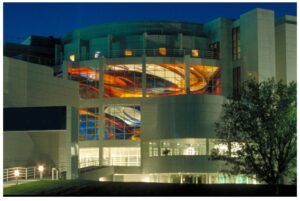
Deanna Sirlin, Retracings, 1999, Collection: High Museum, Atlanta, Georgia, courtesy the artist
Sara Buoso: I was pleased to see Borders of Light and Water at Palazzo Bembo in Venice in 2022. Can you explain how you chose the theme and title of your installation?
Deanna Sirlin: I’m a painter… it’s actually a long story. For me it is not only light, but light linked to color: the idea and the language of color through light are my interests. Light is filtered through my work and creates a prism of color, although it is not really a prism because it is created by the work itself. It is a kind of lens useful to filter the light but also to see through the work; it alters what a person is looking at. I work on multiple platforms, but in the end it’s always about painting and color. Oil painting is transparent, right? It is that brightness of color and layering that makes painting great. My pivotal work, Retracings, 1999, commissioned by the High Museum of Atlanta, Georgia, changed my perspective. I wanted the painting to come out of the wall and into the spectator’s space and be absorbed into the work. The first idea emerged when I decided to enlarge the original paintings by 50%. In this way the paintings became a huge facade. You could see inside the brushstrokes that revealed my process, but there were other surprises. The first time I placed the work on the museum window, I suddenly realized how important it was to see the landscape through my work. This changed everything, and the work was related to the cityscape of Peachtree Street, Atlanta. The brushstrokes are very layered: the whole process has revealed the way I paint on canvas. The layers inside each stroke were made visible. These features illuminate the transparency of color and painting revealed through technology, but also allow the viewer to be inside the painting. I made a small sign that it became the size of the side of the building. With Retracings, my brushwork became something great, without losing its intimacy. The expanded scale has instead created a greater level of intimacy.
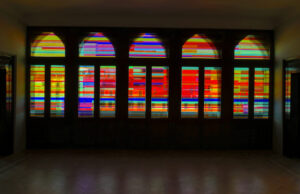
Deanna Sirlin, Borders of Light and Water, 2022, Palazzo Bembo, European Cultural Centre, Venice, photo: Daniele Frison, courtesy the artist
The brushstroke seems to be your specific, unique trait. There is a kind of authenticity in that trait…
The way I paint is very physical. I’ve been painting on the floor for the last five or six years. I think about the physicality of my painting; being inside the artwork is very important. It has to do with connection, intimacy, and I, I’m at work, I’m always at work.
The Borders of Light and Water installation at Palazzo Bembo in Venice was presented in parallel to your Watermark exhibition installation at Crosland Tower, Georgia Tech Library, Atlanta, in 2022. How did you balance similarities and differences between the two installations, also thinking about different artistic, environmental and cultural contexts?
These installations were made simultaneously, but they are different in their essence. In 2022, in Venice, I once again faced the Grand Canal as I had done for the installation Vanishing Point, 2001, commissioned by Ca’ Foscari University. A Venetian architect once shared with me the anecdote that there are two ways of seeing the city: one on foot and one by boat, which is a totally different perspective. Seeing the city from the water is a different way to experience it. The title of the work, Borders of Light and Water, reflects my concerns about boundary issues as artificial and transient. I connected these thoughts with my ideas about water and light in order to address urgent social and climate issues. The palette of the installation takes from the color of the Venetian paintings of the seventeenth century, while addressing the landscape. The work responds to the architecture of Palazzo Bembo; beautiful shape of the gothic arched windows that frame the view of the Grand Canal. In Atlanta, the Watermarkinstallation works differently. The work is inspired by the book Watermark, 1989, by the poet Joseph Brodsky, which is a reflection on his trip to Venice in winter. In 2022 the Georgia Tech Library in Atlanta hosted an exhibition of science fiction books: I decided to tackle this topic because science fiction literature has a relationship with topics like nature and climate change that are of great interest to me. Watermark is inspired by the color palette of illustrated science fiction book covers. It’s very blue, lime green and magenta, very wild and very ’60s: it’s my palette.
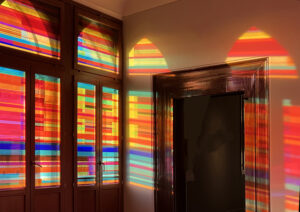
Deanna Sirlin, Borders of Light and Water, 2022, Palazzo Bembo, European Cultural Centre, Venice, courtesy the artist
Painting, color brightness, but also… landscape, architecture and context…
With the exhibition, Strata, held at the Centro de Arte e Cultura, in Évora, Portugal in 2020, I addressed the site and its nature, taking into account the fact that the building was a former court and the prison of the Inquisition; the windows still had the bars five hundred baits. For the exhibition I then had to face the difficult and incredible history of the site. I did this through a work that was installed on twenty windows and in six galleries of the art center. As an artist, I must speak to the place: it is the place itself that informs me, and this becomes the frame of the work and its content.
You’re currently working on the hand-painted, layered digital film, Wandering In, based on a 1970s naturalistic documentary by Edwin Way Teale, an American naturalist.
In May 2022, at the Georgia Tech Library, I had a conversation with a faculty member, Dr Gregory Zinman, a media and film theorist and Nam June Paik expert. He suggested the idea of putting the painting through a 16mm projector to see the result. I loved the idea because it’s projection, it’s light, it’s color, it’s old technology and it’s new technology. But I needed to explore and experiment with cinema… and then this wonderful film came to me by chance as a gift: Wandering Through Winter, 1965, an old-fashioned nature film based on a Pulitzer Prize-winning book by naturalist Edwin Way Teale. And I received another gift when I purchased a wrapping coil that I needed. There was a film on the reel featuring two talking heads: Vice President Lyndon B. Johnson and President John F. Kennedy. I feel that the film is a kind of dialogue and it is a form that allows me to relive and re-articulate the color and light in my painting. I’m adding a layer over Wandering Through Winter, painting over it and making sure the light moves through it and is projected over… But since the film is about nature and climate change, maybe it should be shown on a tree or in a landscape rather than on a traditional medium.

Deanna Sirlin, Watermark, 2022, Crosland Tower, Georgia Tech Library, Atlanta, Georgia, courtesy the artist
You also experiment with collage, digital and video…
I was given a residency at the Rothko Center in Latvia where I made two large paintings, Timing and Places, 2016, which now belong to the collection. I’m a diptych, but everyone has their own separate identity. I even started a third painting before I left, but I knew it wasn’t finished and I took it home to my studio in Atlanta. I identified the pieces of the painting I found interesting. I had already made collages using hand-painted canvas pieces created for this purpose and decided to cut this painting into pieces and collages of new work with fragments. This was the first time that I have re-proposed and recycled my painting. Next, the collage entered the computer. I’m very interested in digital and how your point of view changes. Image enlargement and image manipulation are part of the process. In collaboration with the Portuguese director Nuno Veiga, I transformed my digital collage into a video by superimposing it on moving water movies. The work is called Wavelength, 2022 and was recently exhibited in Atlanta as part of my eponymous exhibition. This video is my version of the old technique of repentance, which brings out some of what’s underneath along with the story of the work.
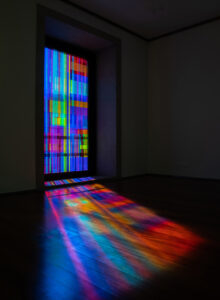
Deanna Sirlin, Strata exhibition, 2020, Centro de Art e Cultura, Évora Portugal, Francisco Pereira Gomes © Fundação Eugénio de Almeida
In a broader context, in which school of thought or style do you identify?
As for my interest in transparency and color, I am influenced by Mark Rothko who was a great colorist, but also by Josef Albers and his theory of geometric color. I grew up in New York and I’ve lived in Atlanta for a long time. In October there is the warmest light you have ever seen: it is completely yellow. In New York, the light is much bluer because of the ocean and its reflection. To close the circle, longitude and latitude are important aspects of perception, but the question is not limited to these. My work is focused on the light passing through this color filter. I create a transparent but saturated color palette and the light moves through it.
On March 22, Deanna Sirlin opened the Wavetable exhibition at 211 East 43rd Street, NYC, NY. Wavetable will be open until 15 August 2023.
Info:

She is interested in the visual, verbal and textual aspects of the Modern Contemporary Arts. From historical-artistic studies at the Cà Foscari University, Venice, she has specialized in teaching and curatorial practice at the IED, Rome, and Christie’s London. The field of her research activity focuses on the theme of Light from the 1950s to current times, ontologically considering artistic, phenomenological and visual innovation aspects.


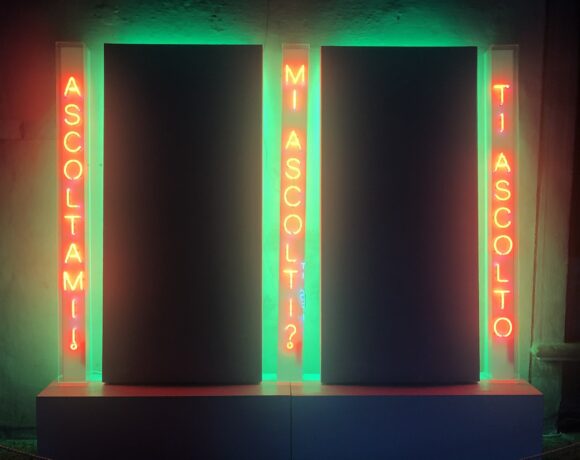
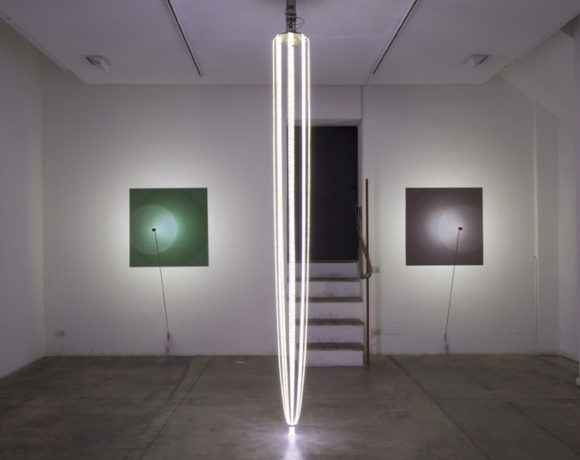

NO COMMENT